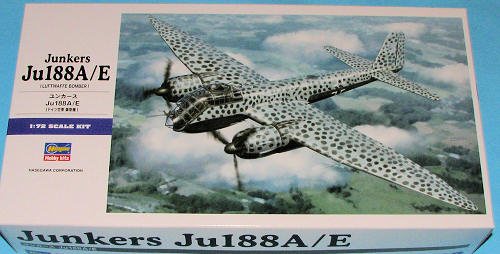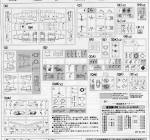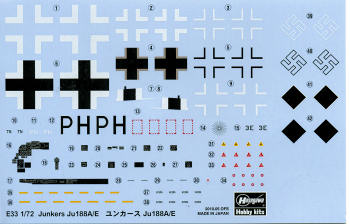
Hasegawa 1/72 Ju-188A/E
| KIT #: | 01563 |
| PRICE: | ¥3,600 from Hobby Link Japan |
| DECALS: | Three options |
| REVIEWER: | Scott Van Aken |
| NOTES: | Initial Boxing |

| HISTORY |
The Junkers Ju 188 was a German Luftwaffe high-performance medium bomber built during World War II, the planned follow-on to the famed Ju 88 with better performance and payload. It was produced only in limited numbers, due both to the presence of improved versions of the Ju 88, as well as the deteriorating war condition and the resulting focus on fighter production.
The Ju 188 was designed to be fitted with either the 1,750 PS (1,290 kW, 1,730 hp) Jumo 213A or 1,700 PS (1,250 kW, 1,680 hp) BMW 801 G-2 engines without any changes to the airframe. It was originally intended that both would be known as A models, but the naming was later changed: the Ju 188A model powered by the 213, and the Ju 188E by the 801.
The first three production Ju 188 E-1 machines were delivered with the BMW engines in February 1943, another seven in March, and eight in April. A conversion testing unit was formed up in May, and after testing were attached to an operational unit, with the first mission, an attack by three Ju 188E-1s on a factory in Lincoln, Lincolnshire taking place on 18 August 1943. By the end of the year, 283 Ju 188s had been delivered (including Ju 188Fs), and two new factories were added to the production effort. Most operational machines differed from the prototypes only in having a 20 mm MG 151/20 cannon in the nose and dorsal turrets in place of the 13 mm (.51 in) MG 131. The MG 131 I was intended to be used in the Ju 188 E-1 or the G-2. But the heavy armament in the A and E series was the MG 151/20. The Ju 188 E-2 was built as a torpedo-bomber, but was identical to the Ju 188 A-3.
Although the A and E models were to have been delivered at the same time, the Jumo engine was still having difficulties getting into production. Nevertheless, the first Jumo powered Ju 188 A-1 versions were shipped only shortly after the BMW versions, albeit at a much slower rate. By the time delivery rates were finally picking up in late 1943, the Jumo was available in a new MW 50 methanol-water injection "boosted" version that delivered 1,648 kW (2,241 hp) for takeoff. With this engine, the planes were known as the Ju 188 A-2, and started deliveries in early 1944.
A modified version mounting a small FuG 200 Hohentwiel sea-search radar set under the nose and shackles for a torpedo for naval strike missions was delivered as the Ju 188 E-2, and with the Jumo as the Ju 188 A-3. The only other difference was the removal of the outer pair of wing bomb shackles.
For all its good points, the Ju 188 was only a small improvement over the Ju 88 it was supposed to replace. The bombload and bomb bay was no larger than the earlier plane, so although it could handle a larger load by mounting externally, doing so hurt performance. Even then the performance was rather poor considering all the effort - only 523 km/h (325 mph) or less. The dorsal turret had only one gun in it, yet the type retained the single-gun flexible position only a few centimeters away from it. In the meantime, the various projects to finally provide the plane with real tail armament were all abandoned.
Delivery problems of the Jumo were never entirely sorted out, and the only model to be built in large numbers were the E series with the BMW 801. Even then so few were available that they were generally given out to Ju 88 units, who flew them on "special" missions where the longer range or better performance would be helpful.
Some 500 Ju 188A and E variants were built up until the summer of 1944, when production ceased.
| THE KIT |
 We
all knew it would only be a matter of time before Hasegawa added the Ju-188 to
their line-up of kits. Since many of the parts are identical to the Ju-88
series, Hasegawa produced a new nose as well as longer wing tips and ailerons.
In order to provide for the two variants, you also get both the BMW and Junkers
engines with their different props. There is a pair of different upper gun
turrets and a blanking plate. An external bomb load of four bombs (2 x 250kg and
2 x 500kg) with their required racks are also in with the kit. The builder
will need to open holes to install these. To be honest, the full load would
probably only be only used for short range so you may wish to consider just
opening two. The kit also includes dive brakes, which were generally only found
on the A model and even then they were frequently removed to save weight.
We
all knew it would only be a matter of time before Hasegawa added the Ju-188 to
their line-up of kits. Since many of the parts are identical to the Ju-88
series, Hasegawa produced a new nose as well as longer wing tips and ailerons.
In order to provide for the two variants, you also get both the BMW and Junkers
engines with their different props. There is a pair of different upper gun
turrets and a blanking plate. An external bomb load of four bombs (2 x 250kg and
2 x 500kg) with their required racks are also in with the kit. The builder
will need to open holes to install these. To be honest, the full load would
probably only be only used for short range so you may wish to consider just
opening two. The kit also includes dive brakes, which were generally only found
on the A model and even then they were frequently removed to save weight.
 Cockpit
detailing is quite good and uses some decals to help with the instruments. As
much can be seen through the clear glazing, it is good that there is so much in
there to see.
Cockpit
detailing is quite good and uses some decals to help with the instruments. As
much can be seen through the clear glazing, it is good that there is so much in
there to see.
Instructions are typical Hasegawa, which is to say they are quite good. Gunze paint references of course, though this time, no mixing is needed. There are three markings options. The Ju-188E on the box art is in RLM 76 upper with black undersides and RLM 70 dots all over the upper surface. Next is another Ju-188E with the same base pattern, but squiggles in a 'mirror wave' pattern on the upper surface in RLM 70. These two planes are from KG 66 in the last years of the war. The lone Ju-188A with the Junkers engines is from 1./KG 6. It has an upper splinter pattern in RLM 70/71 with RLM 65 undersides. The decal sheet is well printed and provides a full set of stencil markings as well.
| CONCLUSIONS |
I know that many have been waiting for this one and the wait is now over. It is another superbly done kit and is sure to make up into an equally fine model.
| REFERENCES |
http://en.wikipedia.org/wiki/JU-188
June 2010
Thanks to Hobby Link Japan for the preview kit. Click on the link to get yours.
If you would like your product reviewed fairly and quickly, please contact me or see other details in the Note to Contributors.